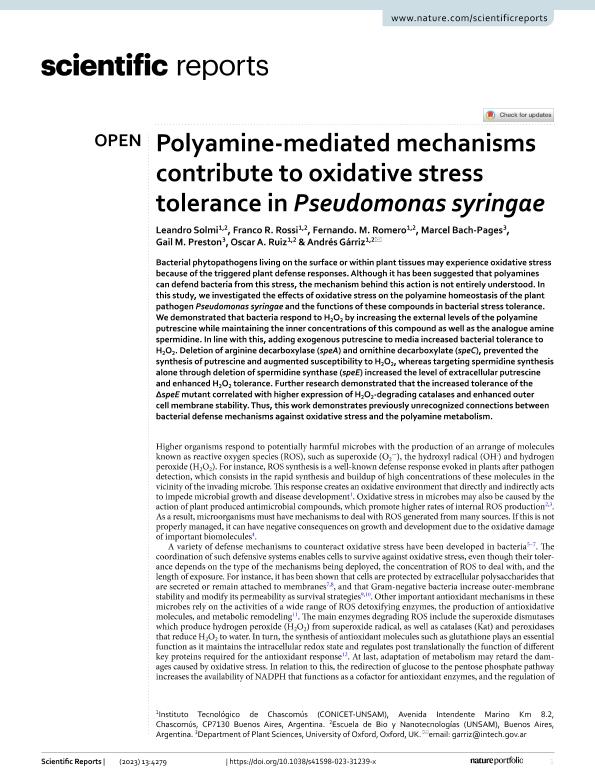Artículo
Polyamine-mediated mechanisms contribute to oxidative stress tolerance in Pseudomonas syringae
Solmi, Leandro ; Rossi, Franco Rubén
; Rossi, Franco Rubén ; Romero, Fernando Matias
; Romero, Fernando Matias ; Bach Pages, Marcel; Preston, Gail M.; Ruiz, Oscar Adolfo
; Bach Pages, Marcel; Preston, Gail M.; Ruiz, Oscar Adolfo ; Gárriz, Andrés
; Gárriz, Andrés
 ; Rossi, Franco Rubén
; Rossi, Franco Rubén ; Romero, Fernando Matias
; Romero, Fernando Matias ; Bach Pages, Marcel; Preston, Gail M.; Ruiz, Oscar Adolfo
; Bach Pages, Marcel; Preston, Gail M.; Ruiz, Oscar Adolfo ; Gárriz, Andrés
; Gárriz, Andrés
Fecha de publicación:
12/2023
Editorial:
Nature Research
Revista:
Scientific Reports
e-ISSN:
2045-2322
Idioma:
Inglés
Tipo de recurso:
Artículo publicado
Clasificación temática:
Resumen
Bacterial phytopathogens living on the surface or within plant tissues may experience oxidative stress because of the triggered plant defense responses. Although it has been suggested that polyamines can defend bacteria from this stress, the mechanism behind this action is not entirely understood. In this study, we investigated the effects of oxidative stress on the polyamine homeostasis of the plant pathogen Pseudomonas syringae and the functions of these compounds in bacterial stress tolerance. We demonstrated that bacteria respond to H2O2 by increasing the external levels of the polyamine putrescine while maintaining the inner concentrations of this compound as well as the analogue amine spermidine. In line with this, adding exogenous putrescine to media increased bacterial tolerance to H2O2. Deletion of arginine decarboxylase (speA) and ornithine decarboxylate (speC), prevented the synthesis of putrescine and augmented susceptibility to H2O2, whereas targeting spermidine synthesis alone through deletion of spermidine synthase (speE) increased the level of extracellular putrescine and enhanced H2O2 tolerance. Further research demonstrated that the increased tolerance of the ΔspeE mutant correlated with higher expression of H2O2-degrading catalases and enhanced outer cell membrane stability. Thus, this work demonstrates previously unrecognized connections between bacterial defense mechanisms against oxidative stress and the polyamine metabolism.
Palabras clave:
Pseudomonas syringae
,
Polyamine
,
Oxidative Stress
,
Hydroxy Peroxide
Archivos asociados
Licencia
Identificadores
Colecciones
Articulos(CCT - LA PLATA)
Articulos de CTRO.CIENTIFICO TECNOL.CONICET - LA PLATA
Articulos de CTRO.CIENTIFICO TECNOL.CONICET - LA PLATA
Citación
Solmi, Leandro; Rossi, Franco Rubén; Romero, Fernando Matias; Bach Pages, Marcel; Preston, Gail M.; et al.; Polyamine-mediated mechanisms contribute to oxidative stress tolerance in Pseudomonas syringae; Nature Research; Scientific Reports; 13; 1; 12-2023; 1-16
Compartir
Altmétricas



